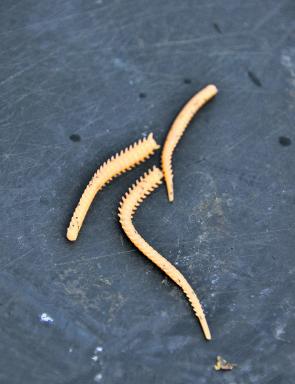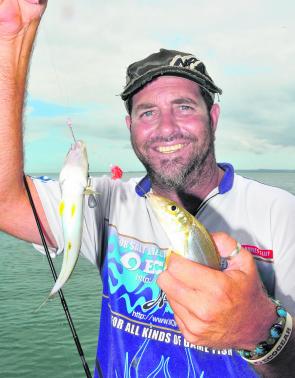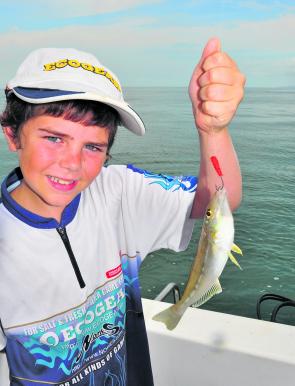Any serious lure fisher in Australia would be familiar with the Ecogear brand of hardbodied and soft plastic lures. Although very popular in Australia, Ecogear is a small branch of the international powder-bait producing giant, Marukyu. This old Japanese company based north of Tokyo is a major player in coarse and other manufactured baits around the world.
Also, readers of Fishing Monthly would be familiar with the Marukyu logo – mainly through the placement of them throughout the magazine for the popular Find the Marukyu Boy competitions.
So, we thought it was time to give you the scoop on what Marukyu’s Isome baits are and how to use them. After all, we’ve given out plenty of them as prizes and you’ll start seeing them more and more in your local tackle stores.
Firstly, Isome is Japanese for sandworm, and if you’ve had a look at the Marukyu Isomes you’ll notice that they are a pretty good replica of a worm. These are artificial baits that are made of 100% land-sourced materials. They’re not reconstituted from anything harvested from the ocean, and Marukyu’s pretty big on that sustainability side of it.
Secondly, the baits smell like blueberries. Seriously. They’ve been designed to be pleasant to handle – especially for kids who may be deterred by the smell of natural baits.
Thirdly, these baits last for a long time. You can keep them on board month after month and when you open the packet, the Isome worms will be ready to use. Also, the colours won’t bleed if you mix up different coloured worms.
So, the obvious question is: Do fish shy away from the worm that doesn’t smell like a worm? Well, Marukyu’s scientists have spent years researching and distilling the combinations of amino acids that trigger a feeding response in fish. Marukyu says that these amino acids are present in the Isome baits in concentrations five to six times the quantities found in natural baits.
We’ve heard that over a million packs of these baits have been sold in Japan and that the Isome worms work remarkably well. Naturally, we thought that the best way to test these claims was to jump in the boat and try it ourselves, so I hooked up with Australian Marukyu pro-staffer Gavin Dunne for a day on the winter whiting in Moreton Bay.
Fishing Monthly readers will remember Gavin as our Brisbane and Moreton Bay columnist for Queensland. His current job is in Product Development with Marukyu. Remember that job you always wanted where you got to go fishing all the time and test out the latest and greatest gear? Yep, Gav’s got that one. Feel free to let him know how you feel about that next time you see him at the ramp!
Launching at Cleveland, Gav headed across to the Rous Channel, a deep water gutter that links Moreton Bay to the South Passage Bar. Gavin was quite particular about the depth and type of bottom he was looking for, usually around 15’ and preferably with broken weed beds. He also looked for current, as he likes the baits to be moving to initially attract the fish.
Our first spot was a little slow. Some small diver whiting and some juvenile sweetlip were caught, but as the day wore on and the current picked up, so did the fishing.
After several location changes, we hit the mother lode, and assembled a fantastic feed of these tasty fish.
Here’s how Gav did it.
Gavin prefers a double rig, paternoster-style, mainly for keeping the baits up and out of the weedy bottom. The weight at the bottom will drag through the weed beds and the baits will hang above it.
Showing some of his flyfishing background, Gavin ties a rig with a couple of short, twisted bases leading to a 50mm tippet that the hook is tied to. Also, Gavin replaces the standard red tubing with a combination of beads. On the day we fished, it was a pair of tiny red beads bookending a larger crystal bead in the middle (see illustration).
“I still haven’t got it fully worked out yet, but some days, the shiny, crystal bead will outfish anything else and other days it’s the opposite,” Gavin said.
Usually Gav won’t cast too far from the boat and he keeps the line tight to transfer the movement of the drifting boat into a moving bait.
“The whiting usually hang on the sand patches in between the weeds and the paternoster rig ensures that the worms are presented weed-free when it hits these key areas,” Gavin said.
“I usually break the big Isome worm into three pieces and use each of these as a bait. I’ve caught up to a dozen fish per segment of bait in the past – or as little as one fish – but generally the bait is pretty tough”.
After that, it’s up to you to hook the fish once it starts biting. Gavin prefers a very soft rod and small spinning reel, but we all know that most tackle is up to the task when it comes to landing whiting.
I’m sold on the concept and sold on the results. Taking the experiment one step further we’ve subsequently tried fishing Isome in one boat and live sandworms in the other. The results weren’t significantly different. Both boats took home a great feed.
It’ll be interesting to see what bait Marukyu replicates next. Until then, enjoy your prize packs of Isome if you won them or look out for them in your local tackle store.
ILLUSTRATIONS
1. Gavin Dunne’s pimped paternoster rig for Marukyu Isome worms.
Reads: 5920
Stored in liquid, Gav would pull some Isome worms out and onto the bait board, ready for rigging. If they dry out too much, you can put them back in the liquid they’re sold in to rehydrate them.

Double trouble. Gavin doubled up on some Rous whiting.

Isome is ideal for kids – smelling like blueberries and catching plenty of fish.




